Generation 8 Breeding Guide
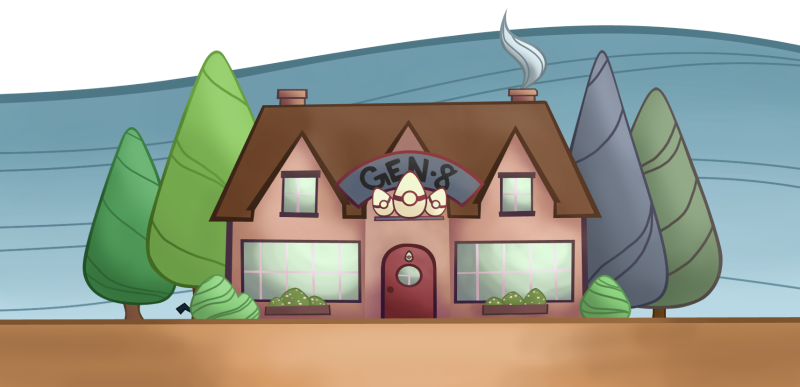
IntroductionBreeding Pokémon Eggs has been an important part of the main series games since its introduction back in Generation 2. The mechanic is useful in many ways, such as hatching Pokémon with perfect stats and natures for competitive battles, gaining access to otherwise unobtainable Egg Moves, and even obtaining high quality shiny Pokémon. In Sword and Shield, the nurseries are located on Route 5 and in the Bridge Field portion of the Wild Area, and in this guide you'll learn everything there is to know in order to become an expert in Pokémon breeding! Breeding OverviewSpecies DeterminationWhen breeding a male and a female Pokémon, it is the female that determines which species the offspring Egg will be. For example, if a female Sobble and a male Chewtle breed together, the Eggs produced will always be Sobble due to Sobble being the female parent. When breeding with Ditto, you can use male, female, or genderless Pokémon to determine the species; breeding genderless Pokémon is only possible when they're paired with Ditto in the nursery, as they do not breed with any other pairing. 
Egg GroupsEgg Groups are categories that determine if your Pokémon are compatible with one another when breeding; if two separate species of Pokémon share the same Egg Group, it is possible to breed them together to create Eggs. However, Ditto is the exception to this because it is unable to breed with other Ditto that share their same group; it is only able to breed with Pokémon of other Egg Groups, barring the Undiscovered Egg Group. If your pairing does not share at least one Egg Group, it will not be possible for them to breed. There are 15 possible Egg Groups:
Baby Pokémon & Alternate Forme BreedingBaby PokémonBaby Pokémon refers to Pokémon that cannot breed at all and require an evolution to be bred. There are 18 baby Pokémon in Sword and Shield: Pichu, Cleffa, Igglybuff, Togepi, Tyrogue, Smoochum, Elekid, Magby, Azurill, Riolu, Bonsly, Happiny, Mantyke, Budew, Mime Jr., Wynaut, Munchlax, and Toxel. IncenseIncense is an item used when breeding to allow certain Pokémon to breed their baby form and is purchasable at the herb shop in Hulbury. Pichu, Cleffa, Igglybuff, Togepi, Tyrogue, Smoochum, Elekid, Riolu, and Toxel do not require an incense, and their evolutions will naturally produce their respective baby form by breeding as usual without an additional held item.
It is important to note that breeding these Pokémon without an incense will not give offspring of their respective baby form. For example, breeding a Snorlax that isn't holding a Full Incense will result in Snorlax offspring, not Munchlax offspring. Keep in mind that, because the Pokémon is holding an incense, the other parent can only hold either an Everstone or the Destiny Knot, meaning you'll have to pick whether you want nature or IVs to be passed down. 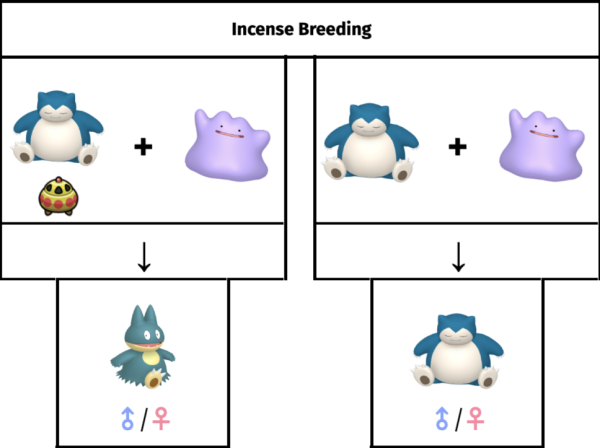
Regional FormesAs with Pokémon Sun and Moon, Sword and Shield brought with them many new regional formes. The non-Galarian formes can be bred if a parent of their corresponding variant holds an Everstone; i.e. a Kantonian Meowth holding an Everstone will result in a Kantonian Meowth Egg, and an Alolan Meowth holding an Everstone will result in an Alolan Meowth. If one of these formes is bred without an Everstone, however, the result will always be the Galarian variant. It's also important to keep in mind that certain regional formes are unable to be obtained through breeding. For example, Alolan Marowak will always breed Kantonian Cubone, as Cubone does not have a regional forme itself; however, since Sword and Shield take place in Galar and not Alola, Cubone will always evolve into Kantonian Marowak. This scenario also occurs when breeding Exeggutor—Exeggcute itself does not have a regional forme, so it will always evolve into Kantonian Exeggutor. Similarly, Weezing always breeds Kantonian Koffing offspring, no matter which forme you use as the parent. The Koffing produced are only able to evolve into Galarian Weezing due to being in Galar, and thus the only way to obtain Kantonian Weezing is through transferring one into your game. Galarian formes also received unique evolutions in Sirfetch'd, Mr. Rime, Cursola, Obstagoon, and Runerigus. These regional formes are only obtainable through evolving their Galarian pre-evolutions. Some are also in Max Raid Dens, such as Runerigus, which has a 1% chance to spawn! The non-Galarian formes of these Pokémon, such as Kantonian Farfetch'd, will never be able to evolve into their regional evolutions; i.e. Kantonian Farfetch'd does not evolve and will not evolve into Sirfetch'd despite being in Galar. 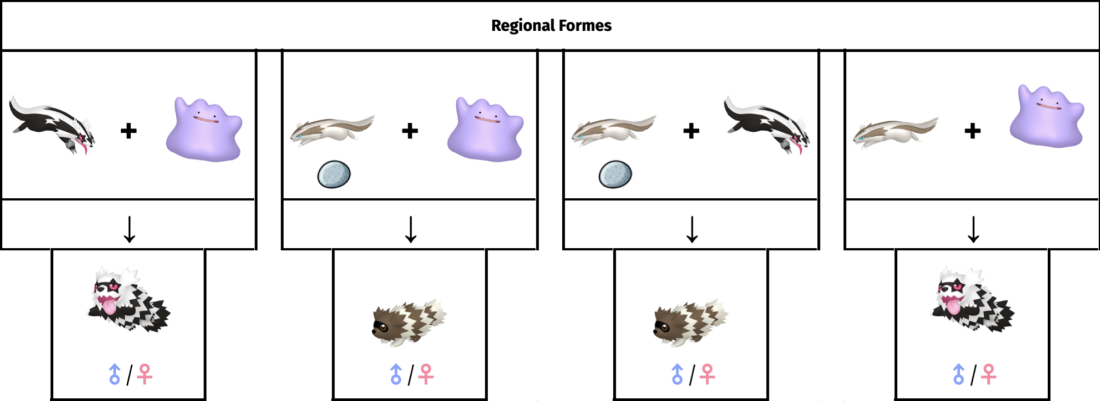
Useful Tips, Tricks, and InformationUseful Abilities and ItemsWhile there are Pokémon useful in the daycare, there are also Pokémon useful outside of the daycare, too. Most notably, Pokémon with either the ability Flame Body or Steam Engine are at the top of the list. Having a Pokémon with either of these abilities in your party causes all Eggs in your party to have their Egg cycles cut in half. Hatching Eggs twice as fast is, as you can imagine, very convenient when you have lots of Eggs to hatch. Keep in mind that this effect does not stack; having four Pokémon with Flame Body and/or Steam Engine in your party will still only halve Egg cycles once, not four times. Beyond useful Pokémon, there are also useful items to consider to ease along the breeding process. No matter which Pokémon you choose to keep in your party to accelerate Egg hatch times, it is optimal to have the front of your party holding a Smoke Ball. It's possible that cycling in circles could lead you into a wild encounter, and being able to flee no matter what is always handy. The Smoke Ball can be found in the Slumbering Weald or held by wild Pokémon such as Koffing, Salandit, and Salazzle, or it can be produced at the Cram-O-Matic through a variety of recipes, more of which can be found here: 
Meanwhile, Poké Dolls can be found scattered across Galar—Circhester and Wedgehurst are two places that they can be found; however, after obtaining two badges, they are sold in every Poké Mart, which is much more easily accessible. The Smoke Ball is preferred, as it is automatically in effect when held, whereas you'll have to activate each Poké Doll through your bag. If you're looking to optimize your efficiency with both abilities and items, using Litwick, Lampent, or Chandelure as your Flame Body Pokémon is a potent idea, as Ghost-types are able to flee from any battles naturally. There are two key items that are needed for breeding flawless Pokémon—an Everstone and a Destiny Knot. There is an Everstone that can be found in Turffield, and it can also be dug up by the Digging Duo in the Wild Area. The Destiny Knot is purchasable in Hammerlocke for 10 BP, and there is a small chance that a high level Pokémon with the ability Pickup will find one. Like the Smoke Ball, both the Everstone and Destiny Knot can also be produced by the Cram-O-Matic. An Everstone is a useful item when breeding because it passes down the nature of the Pokémon holding it. Having the correct nature is of course useful, but you also want to hatch offspring that have perfect IVs as well. The Destiny Knot ensures that 5 of the 12 possible IVs of the parents (6 IVs from the mother, 6 IVs from the father) are passed down to the offspring. This is especially noticeable with perfect Dittos, as they make it exceptionally easy to pass down good IVs to new offspring. Charms are also very relevant items to the breeding process. The first Charm the player should seek out is the Oval Charm in Circhester after completing the game. One has to find Morimoto in the hotel to the right of the Pokémon Center; defeat him in a battle, and the Oval Charm will be presented to the player. This Charm greatly increases the odds that an Egg will be produced, but be aware that this does not mean it can increase odds from zero. Two incompatible Pokémon will never be able to breed, even with the Oval Charm. For those seeking to hunt shiny Pokémon, the Shiny Charm is an invaluable asset as well. This Charm can be found in the same building in Circhester as Morimoto, where the Game Freak director will give you the Charm after showing him your completed Galar Pokédex. The Shiny Charm increases the odds of a Pokémon being shiny from 1/4096 to 3/4096. This effect can be combined with the increased odds of breeding shiny Pokémon with the Masuda Method, raising the chance to 1/512 that an egg will be shiny. DittoArguably the most valuable asset to breeding as a whole, Ditto is a staple to the breeding process. As mentioned previously, Ditto is able to breed with most Pokémon, notably genderless Pokémon that otherwise wouldn't be breedable. Due to producing offspring when paired with the majority of Pokémon, a good natured Ditto with flawless IVs, potentially foreign if attempting to breed for shiny Pokémon, is able to be used for nearly any breeding project. Having a solid Ditto is essential; otherwise, you would have to breed two flawless parents for each project. With Ditto, you only need to breed one flawless parent. As touched upon briefly, foreign Dittos are desired when breeding for shiny Pokémon due to the Masuda Method. This method of breeding will be discussed later on, but the basic idea is that breeding two Pokémon of different languages (GER vs. ENG, not Galar vs. Alola) greatly increases the odds that the offspring will be shiny. Because Ditto is so versatile, using a foreign Ditto gives the player the most optimal parent for breeding correctly natured, flawlessly IVed, shiny Pokémon. Obtaining a perfect Ditto might seem intimidating; however, look no further than this giveaway hosted by Anubis. Here, you can trade a Wooloo for a Japanese Ditto that has the natures and IVs you desire. Be sure to read all of the rules in the first post. Should Anubis's thread be down or deactivated, Smogon Wi-Fi's Giveaway section is another great resource to check for Ditto. If you are looking to obtain your own Ditto, then learning how to do Raid RNG is another great asset. The basic premise behind Raid RNG is typically to save before you enter a Raid, catch the Pokémon, and proceed to using tools such as RaidFinder to find your initial seed—the beginning of what generates everything from natures to genders, IVs, and even shininess of the Pokémon found in your Raid Den. By combining all of this, it is possible to use Raid RNG to obtain your own perfect Dittos, as there is a Ditto Raid den in both the Stony Wilderness section of the Wild Area and in the Workout Sea of the Isle of Armor DLC. Using Raid RNG in order to find parents with already perfect IVs, natures, or Hidden Abilities is also a viable choice for finding the ideal parents. More information on Raid RNG can be found in shiny finder's Generation 8 Raid RNG guide. EfficiencyBreeding is fun of course, but there are ways to optimize it to quickly breed competitively viable or shiny Pokémon, maybe even both on a good day! There are a few in-game settings you can tweak to speed things up. The first of these is text speed—ensure that this is set to Fast to get through dialogue as quickly as possible. Next, turn off the option to nickname Pokémon. Every time an Egg hatches, the game will prompt you to nickname the newly hatched Pokémon. By turning off this prompt, the player will save a few seconds each time an Egg is hatched, which definitely accumulates lots of saved time over the span of long breeding projects. Lastly, there is an option in the settings to automatically send Eggs directly to a box. Make sure that this option is turned on so that, when you collect Eggs, even if your party is full, the Egg will be sent right to your boxes. Without this feature on, you will have to manually send each Egg you collect to the boxes when your party is full. Once your settings have been changed, they should look like this: 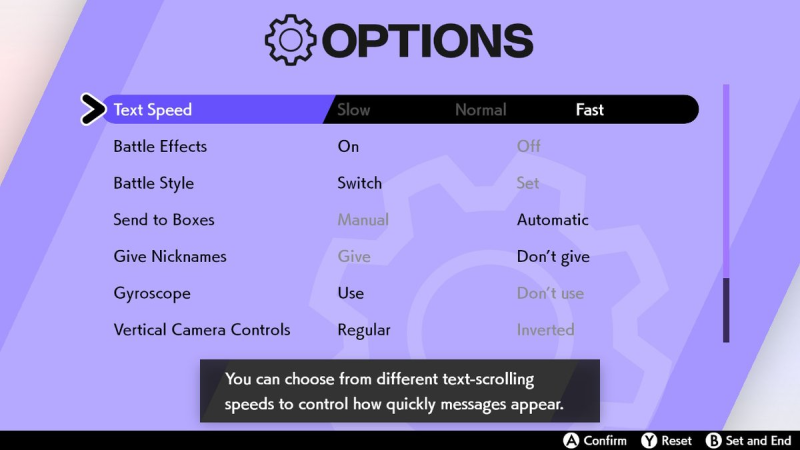
Speaking of your party, it is possible to optimize the layout here as well. Keeping a Pokémon with either Flame Body or Steam Engine at the front of your party (while holding a Smoke Ball or Poké Doll!) and clearing out the remaining five slots for Eggs is preferable. You can either choose to deposit hatched Eggs right into your box and keep collecting them in the process or to collect a bunch then hatch them all at once. Either way, it's best to have as much room in your party as possible. Another way to quickly speed up hatching Eggs is the Rotom Bike, which you obtain on the bridge past Route 5. After obtaining the Bike, head to the Wild Area and speak with any Watt Trader to have him upgrade your Bike in exchange for Watts. Upgrade your Bike as much as you possibly can to receive the longest acceleration time when you use a boost. While it may seem minimal to upgrade your Bike, having these longer boosts is very useful in the grand scheme of everything, as it does save time. One of the most important tools you'll need to easily check the progress of your breeding project is the IV Judge function, which allows you to view any Pokémon's IVs while in your box. In order to unlock the function, the player must first beat the game, head to the Battle Tower in Wyndon, and go through five battles before encountering Leon. After defeating Leon in the Battle Tower, one of the workers at the desk will inform you that the function has been unlocked. To use the Judge, simply press the + button while looking at your boxes and hover over the Pokémon you'd like to check. After pressing +, a descriptor of the IVs will show in place of the Pokémon's stats, and an overall indicator of its IVs will show instead of the moves. The Judge function will remain turned on until you close the game, making checking IVs very easy and efficient. This is crucial to have, as it is one of the guiding aspects of breeding—seeing the progress of the offspring's IVs to continuously replace the parents until a perfect offspring is produced. It enables the player to inch towards higher and higher IV parents with certainty. When the Judge function is unlocked, pressing + will cause the second screen to show instead of the first: 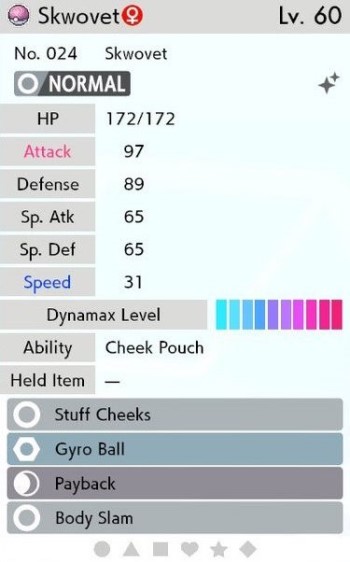 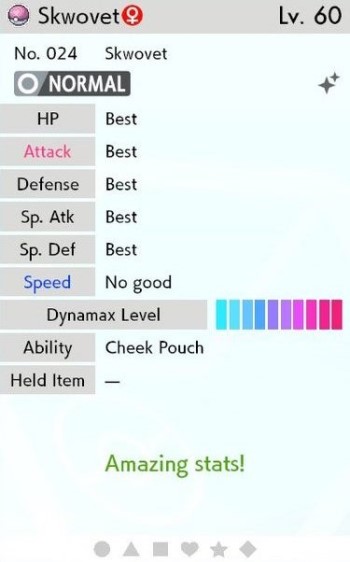
Each description corresponds to a set number of IVs as described below: 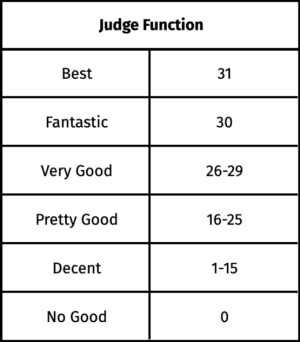
Thus, in the example of the Skwovet displayed above, it has 31 IVs in HP, Attack, Defense, Special Attack, and Special Defense and 0 IVs in its Speed stat. Wi-FiAnother useful outlet for the breeding process is the Wi-Fi room on Pokémon Showdown! Be sure to read over the rules before jumping into the chat. The room comes in handy to potentially find rare Pokémon in Apricorn Balls that people are trading or giving away. Furthermore, it's great for finding and trading breedjects (breed + reject), Pokémon involved in your breeding process that are rejected due to suboptimal IVs or some other deficiency. You can often find trades or giveaways for useful items like rare Poké Balls. Finally, the Wi-Fi room has a shop where you can exchange in-room currency for such items or for breedject Pokémon with Egg Moves in rare Poké Balls. All in all, the room serves as a good resource for breeders of all levels to pick up items and Pokémon! If you're looking for a more forum-based and less chatroom-based approach, then the Smogon Wi-Fi section is another valuable asset as well! Again, be sure to read through the rules before heading into any trade shops or giveaways. Here, you will find plenty of users that post tradeshops, places where Pokémon are advertised for trade. There is also a section dedicated to giveaways, a place where you can find users kindly offering Pokémon. Passing IVs, Natures, Egg Moves, and Hidden AbilitiesIV and Nature InheritanceAs mentioned already, IV inheritance can be controlled partially by giving the Destiny Knot to one parent to hold, and passing down a parent's nature is accomplished through holding the Everstone. The Destiny Knot guarantees that 5 IVs will be passed down. Without the Destiny Knot being held by either parent, only 3 IVs will be picked to be passed down. You can determine a Pokémon's IVs by viewing a Pokémon's stats with the Judge function, where 'Best' = 31 and 'No Good' = 0. These are the most likely IVs you will be breeding for: either 31 IVs in a stat to maximize its potential, or 0 IVs for various reasons, such as to lower a Pokémon's Speed stat for use in Trick Room. Here is a useful tool to calculate the odds of getting offspring with the IVs you're looking for. 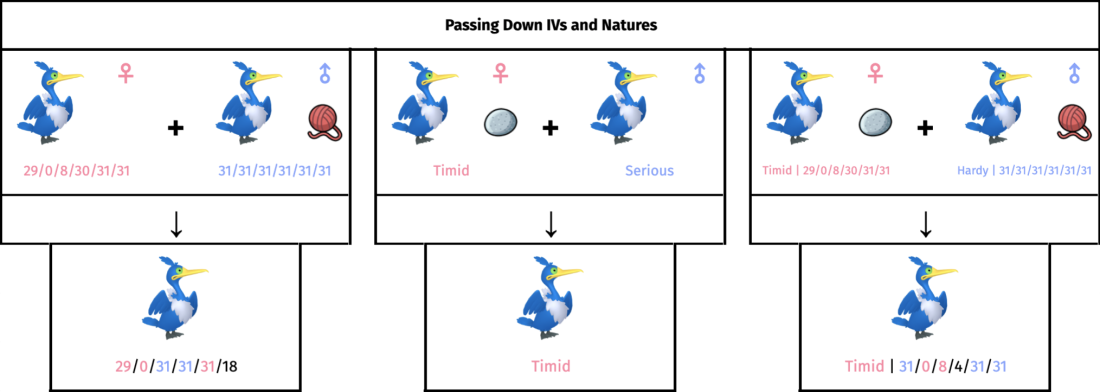
IVs listed in HP/Atk/Def/SpA/SpD/Spe order. Finding Pokémon with solid IVs to start your breeding project might seem daunting, but thankfully the Wild Area has made it increasingly easy to find Pokémon with good IVs thanks to Max Raid Battles. All five-star Raids guarantee to net a Pokémon with four perfect (31) IVs. Four-star Raids will guarantee three perfect IVs, and three-star Raids will guarantee two perfect IVs. However, promotional event distribution and rare Crown Tundra Raids are exceptions to the aforementioned patterns, as the star count of the Raid represents the number of perfect IVs the Pokémon has. This means that five-star Raid guarantee five perfect IVs with both normal and rare beams and, as a result, each star ranking below it will then have one fewer guaranteed IV. Ability InheritanceAnother important aspect of Raids is that you can find Pokémon with their Hidden Abilities. In the Isle of Armor and Crown Tundra, all rare dens guarantee a Pokémon will have their Hidden Ability, while in the main Wild Area or in Event dens, there is only a chance that certain Pokémon will have their Hidden Ability. If all else fails, the Crown Tundra's Max Lair offers an Ability Patch item for 200 Dynite Ore, which changes a Pokémon's ability to their Hidden Ability. This change is permanent, which means you can pass down patched Hidden Abilities while breeding. However, it's impossible to go from Hidden Ability to non-Hidden Ability, so keep that in mind. To pass down a Hidden Ability is fairly simple, with the only caveat being that if two Pokémon of the same species are bred together, only the female will pass down the Hidden Ability. This is another area where Ditto comes in handy, as breeding with Ditto circumvents this restriction, meaning that male and genderless Pokémon can pass down Hidden Abilities as well. Keep in mind, however, that a Hidden Ability Ditto does not affect the offspring—the non-Ditto parent needs to have the Hidden Ability. Parents without the Hidden Ability will never pass down the species' Hidden Ability. Breeding with Ditto is the only way it is possible for genderless Pokémon to pass down their Hidden Abilities as well. There is a 60% chance for a Hidden Ability to be passed down when breeding if either the mother has the Hidden Ability or when breeding with Ditto. 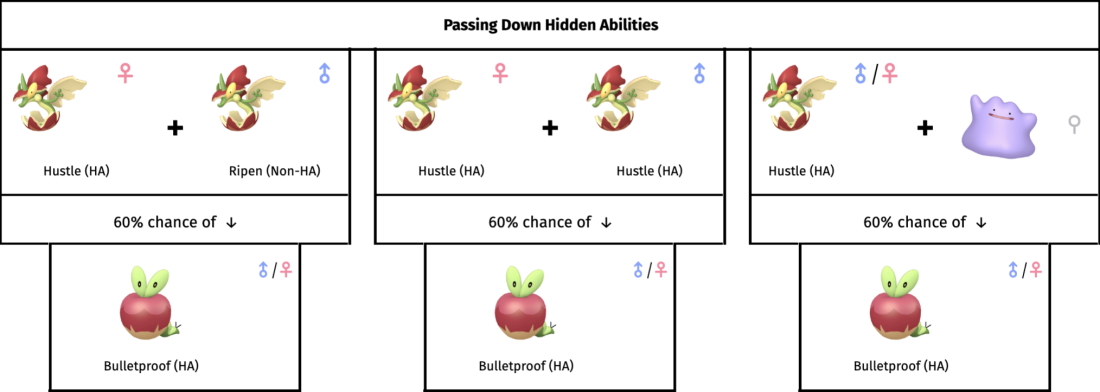
When breeding two Pokémon of the same species without a Hidden Ability, the female's ability has a higher chance of being passed down than the male's. There is a 60% base chance to inherit the female's ability, plus an extra 20% chance because it is not the Hidden Ability. This results in there effectively being an 80% chance to inherit the female's ability. The same odds are applied when breeding a non-Hidden Ability Pokémon of either gender with Ditto. Keep in mind that Pokémon with only one regular ability will always pass down this ability, and that, again, Ditto has no bearing on the offspring's ability. 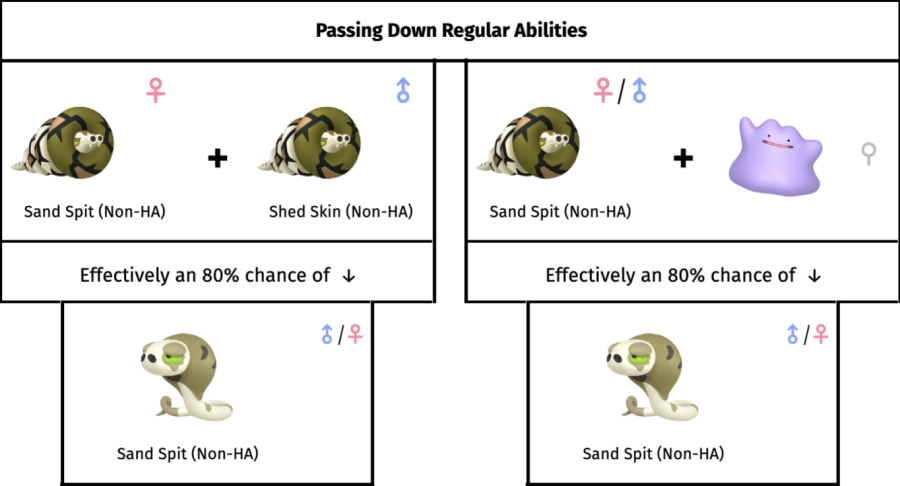
Move IneritanceEgg Moves are another part of breeding that can be essential to breeding competitively viable Pokémon. An Egg Move is any move that a Pokémon learns through breeding that it cannot learn elsewhere, such as through level-up or through TMs. Take Cinderace for example—Cinderace learns Sucker Punch exclusively through passing down this Egg Move to it. These moves are passed down when a female species breeds with a male species of the same Egg Group that knows the Egg Move in question. Going back to the previous example of breeding Sucker Punch onto Cinderace, Thievul, which learns Sucker Punch at Level 28, is in the same Egg Group as Cinderace, the Field Egg Group. Breeding a female Cinderace with a male Thievul that knows Sucker Punch will produce Scorbunny that know the move Sucker Punch. This Scorbunny could also replace the Thievul at this point, as Pokémon are capable of passing their own Egg Move themselves once the moves have been learned. 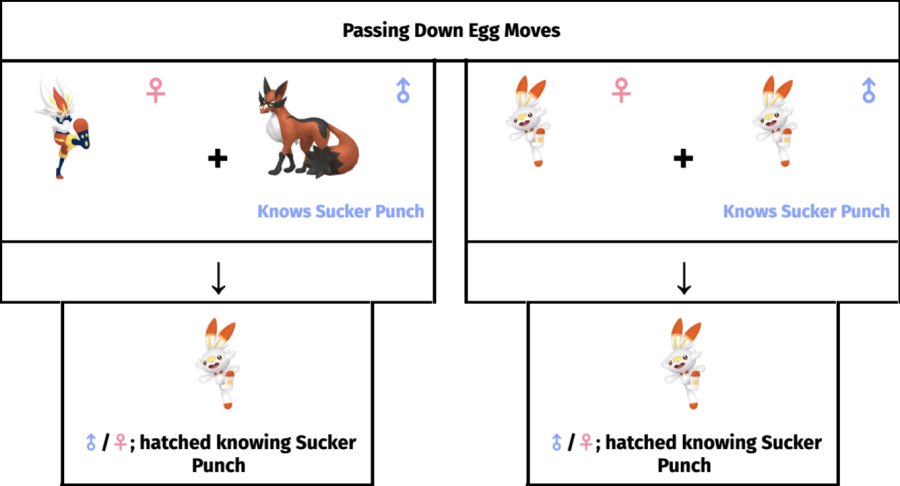
Something new to the Galar region is the passing of Egg Moves through the daycare without actually breeding. This is accomplished by putting two Pokémon of the same species in the daycare together and walking around for a little bit. It is important to remember this method of transferring only works with the same species, meaning Scorbunny + Scorbunny will allow for the transfer of Egg Moves, while Scorbunny + Raboot or Scorbunny + Cinderace never will. If your Pokémon needs room for the Egg Move to transfer, head to any Pokémon Center and delete a move to create space. When deleting moves, you can only delete three at a time, as every Pokémon must have at least one move. This means that, in order to transfer four Egg Moves, you will have to do the transfer cycle twice, deleting three moves at first, transferring three Egg Moves, then deleting the remaining non-Egg Move to make room for the final not yet transferred Egg Move. Pokémon of the same species are able to transfer Egg Moves between each other regardless of the gender. Unlike Egg Moves, transfer moves, such as Defog from USUM tutors, are not able to be passed between Pokémon of the same species this way or bred onto new Pokémon. Similarly, forgetting transfer moves erases them permanently, whereas forgotten Egg Moves will show up at the Move Relearner. ShininessBreeding is one of the most popular ways to hunt for shiny Pokémon due to the ability to control the nature and ball of the Pokémon, as well the possibility for good IVs. The base shiny odds in Pokémon Sword and Shield are 1/4096 to encounter a shiny Pokémon. The Masuda Method for breeding involves using two parents that are different languages, e.g. a Japanese Ditto and an English Dreepy. Using the Masuda Method increases shiny odds to 1/683. Combining the Masuda Method with the Shiny Charm will increase the odds of hatching a shiny Pokémon to 1/512. Whether or not an Egg is shiny is determined when the Egg is generated. To put it more simply, it is possible to save, accept an Egg from the daycare that will hatch shiny, reset, and accept the shiny Egg again. In Generation 8, a shiny Egg will remain shiny when traded to another player, i.e. either player will hatch it as shiny, unlike in previous generations when Egg shininess was determined by the Trainer's shiny value (TSV). Optional Breeding TipsBeyond the basics of breeding, there are a few more things that can be taken into consideration when aiming for the perfect breeding project. Ball InheritanceWhen breeding, the Pokémon determining species passes the Poké Ball. For example, a female Yamper in a Love Ball that is bred with a male Wooloo in a Great Ball will always result in a Yamper hatched in a Love Ball. When the Pokémon being bred together are the same species, then there is an equal 50% chance that either parent's Poké Ball will be inherited. Be mindful that sharing species in this instance directly means you will have to breed together two Yamper for this 50% chance; breeding a Yamper with a Boltund will always result in the female's Poké Ball being passed down. Regional variants being bred together, i.e. a Kantonian Farfetch'd and a Galarian Farfetch'd, will still have a 50% chance for either parent's Poké Ball being inherited, as they are the same species and share the same Pokédex number. When breeding with Ditto, the Ditto's Poké Ball will never be passed down; the Pokémon being bred with Ditto will always pass down the Poké Ball, male, female, or genderless. 
Because of Raids and the Max Lair, Pokémon are able to be in a variety of Poké Balls in a way unlike any generation before! To find more about Poké Ball legality, a guide made by shiny finder can be found here. Ball PreferenceBall preference refers to matching Pokémon to Poké Balls that aesthetically match them, usually by color. One such example is shiny Obstagoon, whose colors align with those of the Lure Ball. Another form of this is purposefully putting Pokémon in Poké Balls which have colors that contrast them, such as a shiny Drednaw in a Quick Ball. Hatch Location PreferenceHatch location preference has to do with hatching Pokémon in a location that thematically matches the Pokémon, such as hatching an Impidimp in Glimwood Tangle or an Eiscue in the Frigid Sea. As mentioned above, the shininess of an Egg is determined when it is generated, so a player wanting to hatch a shiny Pokémon in the perfect location can find their shiny Egg, then reset without saving, collect the Egg again, and bring it to the location where they wish to hatch it. Keep in mind that these are aesthetic decisions the player is free to make—there is no correct or incorrect ball or hatch location preference. Now What? Next Steps After the Perfect HatchAfter breeding your Pokémon, there are several useful items that can be used to enhance your Pokémon further.
ConclusionFrom Ditto, to Hidden Abilities, to IVs, there's certainly a lot to account for when breeding perfect Pokémon. Always remember that breeding Pokémon is meant to be fun, and that you alone decide what a perfect Pokémon is and when to stop a project. Hopefully now you have all of the information and resources you need to breed Pokémon in Pokémon Sword and Shield. Happy breeding! |